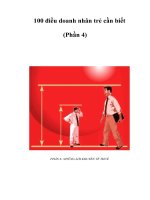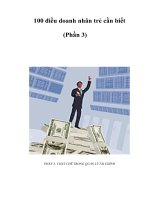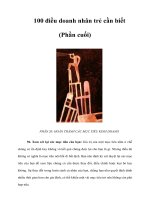Invent Business Opportunities No One Else Can Imagine phần 2 ppt
Bạn đang xem bản rút gọn của tài liệu. Xem và tải ngay bản đầy đủ của tài liệu tại đây (114.43 KB, 20 trang )
Chapter
2
Job #1:
Inventing the Future
Job #1:
Inventing the Future
• 23 •
Chapter
2
“To really help the organization meet today’s business requirements and prepare
for tomorrow’s, vision must be pragmatically and unabashedly bifocal: it must simulta-
neously paint a picture of the opportunities today and the ‘best bets’ of tomorrow, and,
when push comes to shove, it must prioritize the latter.”
—Oren Harari, Leapfrogging the Competition
C
onventional thinking suggests that the upper limits of achievement
are determined by how effectively we build on the past. But this is
a notion that supports the Fatal Assumption.
Almost everything in our
conditioning argues that living
powerfully is founded on past experi-
ence, education, upbringing, developed
skills, successes, and failures. Businesses
build on established assets such as past
strategies, brand equity, resources, market
share, talent, company culture, even the quality of teamwork.
I am proposing that the unique capacity for trendsetting innovation
works in the opposite way.
What if our lives in the present were not merely some variation of
building on the past?
What if we were not limited to simply doing more of the same, better
or harder?
Is it possible to envision a future that is not limited by our history, one
in which our actions bring about changes that could not be predicted?
?????
How do you manage for the
short-term, while also inno-
vating for the future?
Invent Business Opportunities No One Else Can Imagine
24
Isn’t the power to invent the future essential for creating business
opportunities no one else can imagine?
Big Idea #1 represents a shift in priorities on a scale that is rarely wit-
nessed in most companies. The shift rejects the Fatal Assumption in favor
of imagining a desired future and mobilizing efforts to make it a reality.
Big Idea # 1: Today’s strategic priorities must focus on
innovating for the future rather than improving on the past.
This chapter will enable you to capitalize on the power that comes in
mastering this concept. We’ll start by clarifying common misconceptions
about what inventing the future entails. Later, we will examine three meth-
ods used by trendsetters to deliver today’s results, while simultaneously
reinventing their businesses for the future.
The future is a cat burglar
“We think of the future as a soon-to-be-occupied home that will come
to us unburdened by inheritance taxes, mortgage or the like,” wrote futur-
ist Ryan Mathews in Progressive Grocer. “The truth is that the future slips
into our lives like a cat burglar—unknown, hiding in the shadows of the
extended present, lying undetected until its presence fi nally comes to defi ne
the very parameters of our existence.”
Like cat burglars, emerging market trends and competitive strategies
make inroads today, while laying the groundwork for an even larger impact
tomorrow. Rather than suddenly appearing as our reality at some distant
time, the future is subtly taking hold now. The business owner who sleeps
peacefully through the night is likely to wake up and fi nd the jewels miss-
ing. Another business has stolen his prized customers. Unfortunately, the
business owner’s tranquil slumber came from erroneous faith in the Fatal
Assumption. Relying on outdated winning formulas amounts to leaving the
windows open so the cat burglar can clean out the house.
But what if a company was alert to encroaching cat burglars and could
capitalize on emerging changes? That company would be orchestrating its
Job #1: Inventing the Future
25
priorities by focusing greater attention on inventing the future rather than
protecting the status quo.
What is vs. what will be
Every company faces an inevitable tension between what it is and what
it intends to become. Suppose you are an automaker and you truly believe
that, by 2010, the biggest growth in the auto industry will come from elec-
tronic cars. Do you siphon off a larger share of money and talent and
devote it to developing new transportation systems right now? What will
you do to generate the fi nancial windfall from today’s automobiles or other
revenue streams to fund the needed research and development for elec-
tronic cars?
Without question, the envisioned future shakes up short-term plans.
But the opposite is also true. Today’s choices and actions alter the course
of the future. Imagine you are the CEO of a large retail chain that says,
“Our foremost goal is to maximize operational effi ciencies in order to stay
cost competitive.” Will your strategy of making major acquisitions to gen-
erate cost-cutting economies of scale produce a competitive advantage fi ve
years down the road? What if senior management’s attention becomes so
absorbed in milking cost savings out of today’s acquisitions that they lose
touch with shoppers’ changing needs? Five years ahead, you may reach the
point where there is no more fat to cut in expenses, and you are stocking
products that are unappealing to your customers.
We no longer can afford the luxury of focusing all of our attention
on the present or on the future. The future and the present are integrally
linked to one another. Attempting to simplify matters by focusing on one
or the other is ineffective.
Balancing short and long-term priorities sets up continual competi-
tion for resources, time, and focus of attention. But when push comes to
shove, what is the right priority? Trendsetters have no doubt—favor the
long term. Why such fi rm conviction? Because favoring the long term is
the only choice when your goal is to invent business opportunities no one
else can imagine.
Invent Business Opportunities No One Else Can Imagine
26
In chaotic times, every change presents an opportunity to exploit.
Voting irregularities in a Presidential election create demand for innova-
tive products from manufacturers in the voting machine industry, or more
likely, an outside industry trendsetter. If, in seven years, Chinese became
the dominant language for the Worldwide Web, what chaos would that
produce and what opportunities would emerge out of it? The premise is
simple—unpredictability is a threat to replicators but an enormous oppor-
tunity for trendsetters.
This is the essence of Big Idea #1: Trendsetters simultaneously look at
today’s best opportunities and tomorrow’s best bets and, when there’s no
clear winner, they favor the latter. This shift of priorities is the core of what
it means to invent the future.
What inventing the future is NOT
Developing the capacity to invent the future requires a deeper under-
standing of the notion of “inventing.” Let’s fi rst look at the four principle
misconceptions replicators have about inventing the future.
It is not replication
Replicators try to perpetuate favorable market conditions for as long as
possible. Overhauling a winning formula is out of the question. Tweaking
it is an acceptable rate of change.
The apparent blindness to the danger of over-relying on a winning for-
mula is captured in the words of Deng Xiaping: “When you are riding a
dead horse, for heaven’s sake—Dismount!”
Why do so many of us persist in trying to resuscitate a dying horse when
we could hop on a fresh mount? Because we fail to notice the warning signs
of decline that lie camoufl aged among standard measures of business per-
formance. Studying present-day fi nancials alone will not help you separate
yesterday’s peak performers—companies whose best days are in the past—
from those trendsetting companies poised for an explosive growth.
If the numbers don’t provide an answer, how do we predict when rep-
licating the formula for past success will no longer work? After studying
Job #1: Inventing the Future
27
numerous companies over the past 15 years, I have uncovered 10 telltale
signs:
1. The competition has copied the company’s cash cow
products, and customers can’t differentiate between them.
2. Achieving results comparable to those produced earlier, even
just a few months earlier, requires signifi cantly greater effort.
3. Management is obsessed with getting employees to
implement the current strategy more effectively.
4. Employees argue more about who deserves credit for
specifi c accomplishments than what’s best for the company
as a whole.
5. Strategizing for the future happens sporadically because
everyone is dealing with unexpected opportunities or putting
out fi res.
6. Senior managers are under the gun to drive today’s results
through the roof, so developing the next cadre of leaders
takes a backseat.
7. Top talent is jumping ship to more innovative competitors.
8. Employees are putting in longer hours and fi nding it more
diffi cult to satisfactorily balance work and home life.
9. Profi t margins are declining because customers are fi nding
comparable products and services at a better price.
10. The cost of acquiring new customers and increasing market
share is rising.
As these 10 indicators become more evident in your business, your
winning formula will become less effective. To attain or regain competi-
tive advantage, you must analyze the effectiveness of even the most sacred
of your winning formulas. Replicating the past is like trying to ride a dead
horse. It won’t take you anywhere.
It is not improving reaction time
Another common misconception is to regard inventing the future as a
task reserved for those rare visionaries who have uncanny ways of intuiting
Invent Business Opportunities No One Else Can Imagine
28
the next trend. Replicators assume that those who lack such visionary fore-
sight should simply wait for the future to take shape, then react faster than
anyone else.
There is one problem with this approach to handling the future: It is
grounded in self-deception. We don’t have the luxury of waiting for the
future to unfold before staking out a strategic direction, because today’s
choices shape the future we will be reacting to. Today’s choices about
where to invest time and resources create the organizational foundation
(talents, skills, competencies, assets, strategic alliances) for encountering
future circumstances.
While our choices can only be exercised in the present, their impact
simultaneously shapes the future. When choices take on a pattern, the
impact is more pronounced and visible. Boiled down to a simple notion:
When you choose a habit, you also choose the future that comes with it.
When we consistently max out our credit cards or invest astutely, we
are determining the fi nancial resources that will impact choices decades
later in retirement.
When we choose lifestyle habits—remaining sedentary or engaging in
regular exercise—we are determining our physical vitality today as well as
in the future, and may even be infl uencing when we will die.
When we choose certain time management practices—being con-
sumed with the rat race or spending a generous amount of our time
fully present with loved ones—we are determining the quality of love and
respect among our family members for years to come.
Similarly, when senior management routinely uses the previous year’s
winning formula as the basis for the current year’s strategy, that decision
will intensify the competitive battles of the future.
But when leaders rethink business plans to anticipate customers’ latent
needs, they are on the path to produce a strategic advantage that will defy
competitors’ attempts to copy them.
Businesses can no longer afford to wait for the future to emerge and
then hope to replicate it faster and better. Every day they put off inno-
vatively preparing for the future brings them another day closer to imple-
menting antiquated plans.
Job #1: Inventing the Future
29
It is not prediction
Predicting where an industry is headed is a preoccupying question at
gatherings of supply channel members. Trade associations pay enormous
sums to industry analysts and futurists to fi gure out how their industry will
look in the future—5, 10, even 25 years from now.
But replicators place erroneous faith in forecasting. As futurist Richard
Slaughter explains in his book The Foresight Principle, forecasts are based on
if-then reasoning. They require careful analysis of past knowledge. They
then assume that initial conditions will hold and current trends continue
in order to predict a particular outcome with a certain level of confi dence.
For this reason, forecasts can be used as adjuncts to decision making, but
should not be held as authoritative insights into the future. Slaughter con-
tends that predicting any “single” future is actually impossible, because it
fails to account for the active role of humans as agents of change.
Inventing the future requires an adjustment in how we process market-
place information. The core issue involves knowing when to forecast and
when to favor foresight. Forecasting plays a more signifi cant role in short-
term planning, where there is a greater need and likelihood for accuracy
in predication. Accurate predictions are essential for short-term resource
allocation.
As the planning time frame lengthens and the focus is placed on inno-
vation, crystal balls need to be put aside. A different kind of thinking—
strategic foresight—is called for.
Strategic foresight involves imagining a desired future that you can
make happen given changes that have already or might eventually occur.
Trendsetters are proactive change agents who have a stake in bringing
about a future that establishes them in a superior strategic position. Accord-
ingly, strategic foresight requires more speculative, imaginative, and oppor-
tunistic thinking.
In the competitive game of strategic foresight, there is no single dom-
inant future for any industry. There can be dozens of possible futures,
limited only by what industry members can imagine. In developing bold
strategy, imagination is more valuable than prediction.
Invent Business Opportunities No One Else Can Imagine
30
It is not abandoning the past
The replicator’s greatest fear of innovation is rooted in a misconcep-
tion—that inventing the future requires jettisoning the past. There are
some well-known examples that will help us put this worry to rest.
IBM isn’t abandoning mainframes, even while its foreseeable future is
in e-business.
Schwab didn’t get rid of brokers, even though around half of its busi-
ness is e-trading.
Disney retained its fl agship theme park business, even when it expanded
into broader entertainment venues like sports media (ESPN), athletic teams
(California Angels, Anaheim Ducks), video entertainment, and manage-
ment development (Disney Institute).
International Management Group continued to represent athletes while
it expanded to sponsoring and managing sporting events.
Rather than abandoning the past, the central challenge of inventing the
future is in leveraging the past. The most profi table innovations capitalize
on relationships, core competencies, assets, customer knowledge, brand
equity, infrastructure, strategic alliances, and best practices. The trick is to
simultaneously abandon and exploit the past.
Prepare for the cat burglar
Now that the most common misconceptions about inventing the
future have been corrected, the next step is to put Big Idea #1 into action.
Trendsetters use three primary methods to insure their combination of
long-range strategic priorities and short-term plans will refl ect the proper
amount of innovation: dual-focus leadership, strategic foresight, and imagi-
native future planning.
Dual focus leadership
In times of discontinuous change, one of the toughest leadership issues
is determining where an organization’s attention, energy, and resources are
Job #1: Inventing the Future
31
focused. If you concentrate solely on executing today’s plans, you never
see what lies around the curve until you’re hit by tomorrow’s market condi-
tions. At the same time, if you look too far ahead into the future and lose
touch with today’s agenda, your short-term plans will lack crisp execution
and steady accuracy in the midst of what seems like daily changes in market
conditions.
As GE’s CEO Jack Welch describes the dilemma, “You can’t grow
long-term if you can’t eat short-term. Anybody can manage long. Bal-
ancing those two things is what management is.” (Business Week,“Jack: A
Close-up Look at How America’s #1 Manager Runs GE,” 6/8/98. P/ 92).
Escape from this quandary requires practicing a brand of setting priori-
ties, better named, “dual focus leadership.” In stable times, business people
could routinely write out to-do lists containing actions that built linearly on
the prior year’s winning formula. But today’s time allocation choices require a
dual focus on weighing short and long-term implications. Dual focus leader-
ship is the capacity to operate with integrated mind share of the past, pres-
ent, and future tense in making more complex decisions. This integration
of tenses facilitates learning from the past and doing (in the present) what
it takes to usher in the desired future. Let’s examine how the dimensions of
tense—past, present, and future—get treated in an integrated fashion in the
thinking process of a trendsetter.
The most profound access to power through dual focus leadership
comes in recognizing that the future is not merely the outgrowth of a pro-
gression of past events. Rather, the past is seen as an organization’s current
foundation that must be adjusted, destroyed, or transformed to promote
the envisioned future. While the past offers useful information, it does
not become the template of successful precedents that must be carried
forward to insure a successful future. Consequently, trendsetters treat the
future as a vast opening of possibilities and choices, limited only by imagi-
nation. The future only exists as an imagined set of circumstances. In con-
ceiving an original strategy, there is always a huge gap between what you’re
capable of doing in the present and what you need to be equipped to
do in the future. The gap includes needed knowledge, core competencies,
relationships, or the right organizational conditions (culture and structure)
Invent Business Opportunities No One Else Can Imagine
32
essential for implementing the long-term strategy. Closing the gap means
allocating less time to continuous improvement activities that maintain
past routines, while devoting more time and resources to projects that
drive the future strategic position, such as: developing core competen-
cies, product innovation R&D, reinventing roles, studying new minimally
contested markets, pilot testing new products, and rethinking strategy.
Gradually, priorities begin to shift to increasingly refl ect work that sup-
ports the foundation for realizing the desired future.
Once priorities are fi ne tuned, it becomes apparent that the only
tense where choices and actions can be exercised is in the present. The
past exists in memory and the future exists in imagination —choice only
exists in the present moment. For trendsetters, the present serves as
the source of emotional fortitude to sustain vision-driven choices and
actions in the face of newness and uncertainty, and even unwanted
short term outcomes. Since the imagined future exists in the mind’s eye,
moment-by-moment decisions either advance or thwart the conversion
of vision into reality.
A new relationship to time, planning, and readiness for change is
required of trendsetters who are blazing a strategic trail for the fi rst time
and have no trail markers to follow in other’s footsteps. As Watts Wacker,
Jim Taylor, and Howard Means suggest in The Visionary Handbook, rein-
venting your relationship with time is essential, but doesn’t come easy.
“By its very nature, the future destabilizes the present. By its very
nature, the present resists the future. To survive, you need duality, but
people and companies by their very nature tend to resist living in two dif-
ferent tenses.” (Watts Wacker, Jim Taylor, Howard Means, The Visionary’s
Handbook, New York: HarperBusiness, 2000, p.77).
Dual focus leadership is not a natural way of thinking. Our thinking
preferences gravitate to being oriented to either the past or the future.
Plenty of leaders seek the comfort of building a business by leveraging
past precedents. Many shortsighted entrepreneurs fall in love with imagin-
ing scenarios for the future, but fi nd it unnatural to think about instilling
the solid systems and structures that produce effi cient operations.
Job #1: Inventing the Future
33
It is easy to say “Maintain a dual focus” or “When push comes to
shove, favor the decision that best serves the long-term future.” It is quite
another matter to lead by example.
When a manager tells me, “I can’t study future trends. I’ve got a busi-
ness to run,” I take the remark as giving permission for the cat burglars to
pillage. Plenty of managers, obsessed with hitting today’s numbers, never
look up to see what unexpected events might be looming around the
corner. They just keep their heads down and hope they won’t get blind-
sided. In contrast, many visionary entrepreneurs fall in love with imagined
scenarios of the future, without constructing the systems for crisp execu-
tion and steady adjustments that insure proper cash fl ow.
My clients feel overwhelmed that they have the equivalent of two
jobs—a day job where they work on present concerns, plus an after-hours
job where they prepare for the future, such as learning new technology or
preparing to enter global markets. Many feel they are in a no-win situation.
The more effort they pour into preparing for the future, the less time they
have to invest in the present, jeopardizing today’s results. Given a choice,
most people would opt to just do their day job and let the after-hours job
slip. Unfortunately, this choice cripples any possibility for building a foun-
dation for the future.
The demand for holding a dual focus can seem maddening, but only if
we fail to appreciate how accurately it refl ects our ever-changing business
environment. Every decision must be based on how it will help you suc-
ceed today, and more important, how it will help you deliver on tomorrow’s
vision. Once the rationale for maintaining a dual focus makes sense, there
is no point in fi ghting reality, so stress vanishes. Normalizing the healthy
tension between present and future can be liberating. Freed from the con-
fi nes of today’s prerequisites, the pursuit of tomorrow’s compelling vision
can be exhilarating.
In executing an original strategy, the trendsetter recognizes the gap
between what they are capable of doing in the present and what they need
to be equipped to do in the future. Closing the gap means allocating less
time to continuous improvement and reacting to crises. In turn, this shift of
Invent Business Opportunities No One Else Can Imagine
34
priorities frees up more time to develop core competencies, promote R&D,
reinvent roles, study minimally contested markets, track future trends, and
test and launch new products. Gradually, more time is spent in activities
that support the desired future than in refi ning what has worked in the
past.
Here is a list of dual-focus adjustments you can make in the following
commonplace business activities:
Decision-making. Establish a decision-making process where team
members always employ criteria that refl ect both short- and long-term
implications.
Job descriptions. Scrutinize job descriptions for relevance to today’s and
tomorrow’s customers, both internal and external. Discuss how roles can
be reinvented to better serve customers’ future needs, then design posi-
tions accordingly.
Strategic planning. Establish the ground rule that strategic deliberations
always include a dual focus. When targeting markets, consider those that
are well established and those that are emerging. In analyzing competition,
look at current competitors as well as companies that might eventually
compete. When discussing distribution, contemplate current methods as
well as novel channels for getting products to market.
Top-to-top customer meetings. Rethink the strategic value gained from meet-
ings between the top executives of supplier fi rms and their commercial
customers. Share future trends information that impacts your joint future;
inquire into provocative strategic questions for which there are no easy
answers; focus on co-creating an ideal relationship to deliver to your shared
interests. For example, Johnsonville Sausage asks key retail accounts, “How
would you defi ne great performance from us as a manufacturer in this cat-
egory?” The resulting defi nition of great performance then leads to map-
ping out the teamwork requirements for both parties to deliver on a shared
vision of greatness.
Performance reviews. Besides appraising past performance strengths and
limitations, the review is an excellent opportunity to talk about career aspi-
rations. Conversations might include inventing roles that don’t currently
Job #1: Inventing the Future
35
exist, but which are necessary to serve the emerging needs of external or
internal customers.
Trade show debriefi ng sessions. When discussing what you learn from talk-
ing to customers, observing competitors booths, and attending educational
seminars, go beyond planning for immediate sales opportunities. Broaden
the discussion to include long-term implications for key account strategies,
as well as new product or service ideas.
This list demonstrates only a few opportunities for dual-focus leader-
ship in business matters. I recommend preparing your own list. Begin with
your job description and primary responsibilities, the teams you’re on; and,
fi nally, the broader organizational matters that affect you indirectly. Keep
considering how your customary work activities and company operations
can be modifi ed to encompass dual-focus planning.
Strategic foresight, not forecasting
While often used interchangeably, business forecasting and strategic
foresight call for different types of thinking and produce different out-
comes. Forecasting relies on logical reasoning and quantitative analysis to
accurately predict the near future. Strategic foresight uses trend informa-
tion and knowledge of ongoing changes to stir the imaginative thinking
necessary to detect the novel opportunities likely to emerge in years ahead.
Trendsetters employ strategic foresight to discover intensifying latent
needs and then conceive relevant products, services, and business models.
A simplifi ed way of portraying strategic foresight is by distinguishing three
categories of information: industry trends, contextual trends, and current
changes.
Industry trends include predications and future scenarios of industry
leaders, industry experts, and trade association studies.
Contextual trends include legal, demographic, economic, agricultural,
political, technological, environmental, and global trends, which offer pred-
ications about events that might materialize 10, 20, or 30 years from now.
Futurists, think tanks, and government-sponsored studies are sources of
these types of trends information.
Invent Business Opportunities No One Else Can Imagine
36
The fi nal category, changes already happening, includes events happen-
ing right before our eyes in movies, fashion, art, sports, religion, politics,
books, and travel. This category includes changes anyone could observe at
work, in their neighborhood, among family members, even by reading the
USA Today Life section.
While all three categories of information are valuable, certain ones
lend themselves to formulating truly original strategic foresight. Industry
trends offer the least chance of separation from the competition. These
trends are well known by all the major industry players, so there is noth-
ing proprietary about them. Contextual trends offer an edge to companies
who track information beyond the narrow confi nes of their industries.
The broader sweep of trend information offers a better chance for devel-
oping original strategic foresight than competitors who only know industry
trends. Both the industry and contextual trends are plausible assumptions
about how the future might turn out, but they are not highly reliable.
Very often, the richest of the three categories is changes already hap-
pening. We don’t know whether these changes will become enduring and
encompassing trends, but they are real-life situations that a trendsetting
organization can interact with in co-creating new products or services.
The founding of Starbucks is an impressive demonstration of strategic
foresight that helped create the specialty beverage industry. Here are a few
emerging trends Starbucks could have been aware of at the time of it’s
founding in the mid-1980s:
• Consumers were hassled and stressed out.
• Consumers were time-poor.
• Consumers placed high value on convenience.
• Consumers were aging.
• Consumers lacked a place to hang out between home and
work.
• Consumers were working in home offi ces and
telecommuting, and lacked much human interaction.
• Consumers were becoming more fl avor-oriented.
Job #1: Inventing the Future
37
• Consumers were rejecting imitations.
• Consumers were cost conscious and wanted the right value
at an affordable price, especially when it came to coffee.
• Health conscious Baby Boomers were moving away from
caffeine.
Howard Schultz, founder and CEO, got his original vision while
attending a trade show in Italy where he was fascinated by the integral
part coffeehouses play in the social life of Italian cities. He recognized
that Americans needed a place outside of work and home, where they
could feel safe, relax from the day’s hectic pace, and where the environ-
ment was conducive to conversation, reading, or using a computer. In addi-
tion, he realized more and more consumers were working out of home
offi ces and needed a relaxed place to meet with prospects and clients. From
these insights, Schultz and company practically created an institution. Now
exotic coffee drinks custom prepared in an attractive surrounding provide
an affordable luxury for almost everyone.
The imagination of Starbucks leadership transformed a functional
commodity product by infusing it with a dose of emotion. The power of
this emotional connection results in an unwavering brand loyalty such that
Starbucks now sells chocolates, jazz CDs, books from Oprah Winfrey’s
book club, water purifi ers, even sandwiches and side salads.
Starbucks didn’t fi gure out the dominant future where the coffee indus-
try was headed—they invented it.
As Shultz foresaw, “If it captivates your imagination, it will captivate
others.” Starbucks founders leveraged their collective imagination to create
a value offering based on a synthesis of consumer changes that were
already apparent.
Which other companies had the same trend information about con-
sumers? Nescafe, Maxwell House, and Folgers. These coffee powerhouses
confi ned their product distribution to supermarkets and restaurants. They
had the same data as upstart Starbucks, just not the same imagination.
Starbucks’ success proves that signs of emerging trends are everywhere,
for anyone to observe. But how do you learn to see them? By getting in the
Invent Business Opportunities No One Else Can Imagine
38
habit of practicing techniques that sharpen your imagination and develop
your strategic foresight. Here are some suggested exercises:
Assemble a group of colleagues to track the three categories of trend
information. During normal reading, TV watching, or conversations, the team’s
members should be alert to clipping or writing down trend information.
Each month, have the team prioritize the collection of trends that
suggest growth opportunities for your business. Prioritize about a dozen
opportunity-laden trends, looking for patterns in trends that seem to
amplify the same customer needs.
Finally, the team should inquire into this set of questions: If x, y,
and z became full-bore trends, which customer needs would intensify? If
those customer needs intensifi ed, which product or service offerings would
become appealing?
Imaginative future planning
Cat burglars are threatening Fed Ex’s long-standing advantage in ser-
vice reliability. “What does Federal Express do now, in a world that may
not absolutely, positively need it overnight?” asks Douglas Blackmon in a
front-page article in The Wall Street Journal.
E-mail delivers documents instantly. UPS has a greater share of the
booming consumer e-commerce deliveries. But even more foreboding,
business customers are deploying new supply channel management sys-
tems that make the fl ow of materials more predictable. All these cat bur-
glars are reducing demand for overnight service. If you were sitting in
CEO Fred Smith’s chair, what would you do?
True to its strategy, Fed Ex has repositioned itself as an inventory
elimination business with select corporate accounts. Through a program
called Emerge, Fed Ex aligns dozens of global shipments to a common
just-in-time arrival point, virtually eliminating its customers’ need to store
inventory.
If your business is not currently facing a strategic crossroads like the
one confronting Fred Smith, your high-stakes dilemma is coming soon.
Job #1: Inventing the Future
39
Inventing the future is not optional; it is a survival imperative and it bears
with it an uncomfortable truth: The more the envisioned future departs
from current reality, the greater the risk of being ill-equipped to take the
steps necessary to make it happen.
The growing gap between vision and reality calls for a shift in strategic
planning methods, from a customary approach called “incrementalism,”
to the trendsetter’s forte in “imaginative future planning.” Incrementalism
treats
key business measures from the recent past as indicators of the orga-
nization’s performance. This linear approach to strategic planning involves
examining the key results of
recent years (sales, costs, profi tability) and
adjusting them up or down a few percentage points for the next planning
period. The vision of the future is an extrapolation of past results. Incre-
mentalism conveys a preserve-the-status-quo bias anchored in a rigid his-
torical view of customers, competitors, products, and services. The Fatal
Assumption reigns. The future becomes hostage to past history.
Imaginative future planning radically departs from incrementalism and
emphasizes a brand of thinking that is speculative, visionary, and expan-
sive—one that challenges familiar patterns. It requires rethinking the fol-
lowing seven core elements that comprise a strategic position, typically
targeted three to fi ve years into the future:
What business are you in? A business can be defi ned in three ways—by
its products and services, benefi ts to customers, and core competencies.
This defi nition specifi es the range of company products and services. It
makes an enormous difference, for example, whether McDonald’s catego-
rizes itself as being in the hamburger or youth entertainment business;
whether Nike is in the recreational footwear or athletic performance and
fashion business; whether Harley-Davidson is in the motorcycle or lifestyle
makeover business.
Who will be your future customers? Consider established markets and
emerging markets. Be on the lookout for new ways of confi guring markets,
also referred to as “white space.” At the time of their founding, industries
like wellness, extreme sports, home improvement, and specialty beverages
were considered white space.









